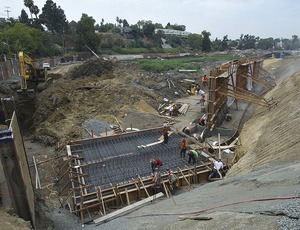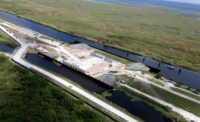Best Water/Environment Project, Southern California: Echo Park Lake Rehabilitation, Los Angeles


The Echo Park Lake Rehabilitation brought back to life a historic watershed in the heart of Los Angeles. The lake began as a drinking water reservoir in the 1860s and eventually became a flood control basin and recreation area. Thanks to this $26.3-million project, the watershed has been remediated to help the city meet Clean Water Act mandates while maintaining flood control functions and enhancing the Los Angeles River Watershed.
The rehabilitation routes all upstream dry weather urban runoff, and 25% from wet weather, from 769 acres of urbanized watershed through the lake to be treated by hydro-dynamic separators and various constructed or restored wetlands. This offers the additional benefit of providing wildlife habitat at the lake. Construction also included an automated aeration system and adjustable outlet weir.
Prior to the rehabilitation, exfiltration through the retaining walls and basin required significant potable water to keep the lake full. To minimize water loss, an innovative liner system was added that uses native clays found on site that have been reconditioned with naturally occurring bentonite. One Best Projects judge praised the team for designing this cost-effective, creative and sustainable solution, rather than using synthetic liners.
During construction, the project site needed to remain available for use as a storm detention basin. Through partitioning, creating bypassing flows and benefiting from a dry winter, the team was able to complete the project on schedule and under the original cost estimate. Formal partnering sessions required by the owner throughout the construction phase helped to create a unified team and resolve any disputes quickly.
Judges remarked that instead of seeing an impaired body of water, visitors will now find much to enjoy with the park's many enhancements, including improvements to the lake's iconic fountain, a new boardwalk displaying educational signage and reestablishment of the lake's 1920s Chinese lotus beds. The lotus plants help to boost water quality while serving an integral role in the local community's annual Lotus Festival.
Key Players
Contractor Ford E.C. Inc., Los Angeles
Owner City of Los Angeles Bureau of Engineering
Lead Design Black & Veatch, Los Angeles
Civil Engineer Brown & Caldwell, Los Angeles
Landscape Architect AECOM, Los Angeles
Geotechnical Engineer Ninyo & Moore, Irvine
Consultants Brinkerhoff & Associates, Fallbrook; Coast Surveying, Tustin; E2 Consulting Engineers, Emeryville






Post a comment to this article
Report Abusive Comment